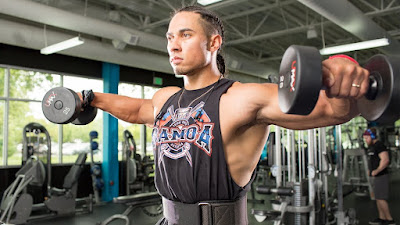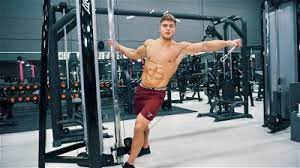What are the lateral deltoids?
The lateral deltoids are a muscle located on the outermost part of the shoulder. This muscle is responsible for raising the arm out to the side (abduction). The lateral deltoids are often referred to as the "side delts."
While the anterior (front) and posterior (rear) deltoids also play a part in moving the arm out to the side, the lateral deltoids are the primary muscle responsible for this movement. This is why exercises that target the lateral deltoids are often referred to as "abduction exercises."
Why are the lateral deltoids important?
The lateral deltoids are important for creating balance in the shoulder muscles. If you only train the front deltoids, you will create an imbalance in the shoulders that can lead to injury.
In addition to creating balance, training the lateral deltoids will also:
- Make your shoulders appear wider
- Help you raise your arms higher (useful for activities like overhead pressing)
- Improve your shoulder stability and strength
Anatomy of the shoulder muscle
The shoulder is made up of three main muscles: the anterior (front) deltoid, the lateral (side) deltoid, and the posterior (rear) deltoid.
The lateral deltoids are the largest of the three muscles and are located on the outside of the shoulder.
Whereas the front deltoids are activated during pressing movements and the rear deltoids are used for rowing movements, there are not many compound movements that truly test the side deltoids meaning they have to be directly targetted through isolation movements and overhead pressing.
The 7 best lateral deltoid exercises:
The cable lateral raise is a great movement for developing the side delts and can be performed on a single cable station with a stirrup attachment. It is a great exercise for supersetting with cable front raises or bent over cable raises as part of your shoulder workout.
By using a light weight with a slow, controlled movement, you can really connect with the lateral deltoids and force hypertrophy. Cables give a constant resistance throughout the movement, unlike dumbbells which do little for the first 25% of the motion.
To perform a lateral raise on a cable machine, follow these steps:
- Attach a stirrup attachment to the cable and set the pulley pin to a low height.
- Hold the attachment with your palm facing your body and raise your arms out to the side, keeping a slight bend in the elbow.
- Breathe out as your raise the cable.
- At the top of the movement, hold the position for a second or two.
- Slowly return to the starting position over a count of 5. a
- Repeat for the required number of reps and sets.
When performing the lateral raise, keep these tips in mind:
Keep a slight bend in your elbow throughout the movement.
Do not swing your arms – raise them slowly and under control.
Do not arch your back or lean to one side during the exercise.
Focus on contracting your lateral delts as you raise your arms.
If you can not feel the connection with your lateral delts when performing the movement, try reducing the weight and going even slower on the lift.
2 - Lateral raise with dumbbells
If you do not have access to a cable station, dumbbells are the next best option for lateral raises. You can generally train with a heavier load with dumbbells as you can loosen your form but make sure that you are fully warmed up.
Start with a light pair of dumbbells to get blood into the muscles and warm up the rotator cuff before pyramiding up to your working sets.
The movement is the same as the cable lateral raise. Many experienced lifters prefer dumbbells as they are able to swing the upper body slightly and cheat the movement allowing the to shift bigger dumbbells.
There are certain benefits to doing this but it should not be attempted unless you have a lot of experience, string shoulders and are prepared to risk injury for bigger gains.
If your gym has a lat raise machine, you should take full advantage of it. The machine offers a constant resistance and a quick weight selection making it ideal for drop sets.
Drop sets are a fantastic way to finish off your lateral deltoid workout as the muscle reacts well to intensity and volume.
To perform a drop set, you simply select a weight and perform as many reps as possible until failure.
Once you reach failure, you quickly reduce the weight by around 30% and continue to pump out the reps until failure again.
You can perform double drop sets or triple drop sets for an even more intense workout.
4 - Arnold press
Arnold presses get a lot of negative publicity but that is generally from people that have never used them. When used in part of a circuit with upright rows and rear delt raises, you can get an intense shoulder workout and a great pump.
Arnold presses are also great as a warm-up to a heavy shoulder session as they get blood into the muscles, warm up the shoulder joint and activate the rotator cuff.
to perform an Arnold press, start with the dumbbells at shoulder level with your palms facing you.
From here, press the weights overhead while rotating your palms so that they face forwards at the top of the movement.
Lower back to the start position and repeat for reps. Remember to keep your core engaged throughout the exercise and do not arch your lower back
5 - Overhead press
Until fairly recently, lifters believed that the overhead press only really benefitted the anterior deltoids and many left this out of their programs as they did not need to target these muscles after a heavy bench session.
Although the anterior delts are the main contributor during an overhead press, the lateral delts are also heavily activated especially when a heavy load is used.
6 - Upright Row
Many lifters will not use upright rows as they find the angle of the movement uncomfortable so deem it unsafe. If you have limited wrist and shoulder mobility, this may be the case but if you do not, upright rows are perfectly safe.
They do put more strain on the rotator cuff than other movements but as long as you warm up thoroughly and use a moderate weight, you should not have any problem.
No other movement hits the shoulders from the same angle as the upright row making it great for developing the lateral delts, rear delts and upper traps,
You can perform upright rows with a barbell, dumbbells, smith machine or on a cable machine.
7 - Egyptian raises
This brings the lateral delts into action much earlier in the movements and hits it from a different angle to a regular lateral raise.
To perform an Egyptian raise in the gym just follow these simple steps:
- Stand next to a wall support or cable machine with a dumbbell in one hand.
- With the other hand, grab hold of the wall or machine for support
- Slowly lean away from the support keeping your back straight until you feel a stretch in your chest muscles.
- From here, raise the dumbbell out to the side until your arm is parallel with the ground.
- Hold for a second at the top of the movement and then lower back down.
- Repeat this movement for the required number of reps and sets.
How often should I perform a shoulder workout?
The three muscles in the shoulders repair at a slightly different rate due to the fibre makeup and day-to-day use.
The rear deltoids recover very quickly after a row workout or shoulder workout and generally only need 24 hours to recover. This means that they can be trained 3-4 times a week if you are looking to achieve maximum hypertrophy.
The front deltoids are used a lot in pushing movements such as the bench press or military press and as a result, recover slightly slower than the rear delts. For optimal hypertrophy, try to add front raises or Arnold presses on to the end of a heavy pressing session twice per week. This gives the front delts at least 60 hours to repair.
The lateral deltoids are somewhere in the middle and can be trained every 48-72 hours. This means that they can be trained on back to back days, or every second day.
We have found the following split to work well for building maximal deltoid size:
-Monday: Heavy pressing + front raises
-Tuesday: Lateral raises + rear raises
-Thursday: Heavy pressing + front raises
-Friday: Lateral raises + rear raises
-Saturday: Rear raises
Other exercises can be added around this split for maximum hypertrophy. Check out our free training split, HyperGrowth which builds a whole training program around muscle fibre type and optimal training frequency.
Shoulder workout risks.
The risk of shoulder injury when weight training is high, so make sure you warm up properly before each session. We recommend using a lightweight for 15-20 reps as part of your warm-up set.
Start light and focus on feel. As you become more comfortable with the movement, add weight accordingly. Remember to keep good form throughout the entire range of motion. If you start to feel any pain, stop the exercise immediately.
Most shoulder injuries occur when the joint is placed in a position of extreme extension (think: handstands, push-ups) or flexion (think: overhead pressing). Avoid these positions if you have any history of a shoulder injury.
Conclusion
If you want a wider upper body frame and a better aesthetic, weight training and a good diet are the way to get there. By adding the above exercises into your training routine along with a protein-rich eating plan, you should see noticeable results within a few weeks.









